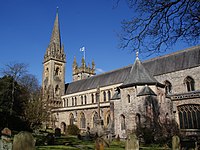
Back Llandaffská katedrála Czech Eglwys Gadeiriol Llandaf Welsh Kathedrale von Llandaff German Catedral de Llandaff Spanish کیلسای جامع لانداف Persian Llandaffin tuomiokirkko Finnish Cathédrale de Llandaff French Katedral Llandaff ID Cattedrale di Llandaff Italian Ecclesia cathedralis Landavensis Latin
| Llandaff Cathedral | |
|---|---|
| The Cathedral Church of Saints Peter and Paul with Saints Dyfrig, Teilo, and Euddogwy | |
Eglwys Gadeiriol Llandaf | |
 | |
| 51°29′45″N 3°13′04″W / 51.4957°N 3.2179°W | |
| Location | Cardiff |
| Country | Wales |
| Denomination | Church in Wales |
| Website | www |
| History | |
| Status | Cathedral |
| Founded | 1120 |
| Architecture | |
| Functional status | Active |
| Style | Medieval, Gothic |
| Administration | |
| Diocese | Llandaff |
| Clergy | |
| Bishop(s) | Mary Stallard |
| Dean | Jason Bray (from 8 September 2024) |
| Precentor | Ian Yemm |
| Canon Chancellor | Jan van der Lely[1] |
| Laity | |
| Director of music | Stephen Moore |
| Organist(s) | Aaron Shilson, David Geoffrey Thomas |
Llandaff Cathedral (Welsh: Eglwys Gadeiriol Llandaf) is an Anglican cathedral and parish church in Llandaff, Cardiff, Wales. It is the seat of the Bishop of Llandaff, head of the Church in Wales Diocese of Llandaff. It is dedicated to Saint Peter and Saint Paul, and three Welsh saints: Dubricius (Welsh: Dyfrig), Teilo and Oudoceus (Welsh: Euddogwy). It is one of two cathedrals in Cardiff, the other being the Roman Catholic Cardiff Metropolitan Cathedral in the city centre.
The current building was constructed in the 12th century on the site of an earlier church. Severe damage was done to the church in 1400 during the rebellion of Owain Glyndŵr, during the English Civil War when it was overrun by Parliamentarian troops, and during the Great Storm of 1703. By 1717, the damage to the cathedral was so extensive that the church seriously considered the removal of the see. Following further storms in the early 1720s, work was begun in 1734 on a new cathedral designed by John Wood, the Elder, but this was never completed, and instead a major restoration by John Prichard was carried out in the 1840s and 1850s. In January 1941, during the Cardiff Blitz of the Second World War, the cathedral was severely damaged by a parachute mine that blew the roof off the nave, south aisle and chapter house. The stonework which remains from the medieval period is primarily Dundry stone from Somerset, though local blue lias constitutes most of the stonework dating from the post-Reformation period. The work done on the church since World War II is primarily of concrete and Pennant sandstone, and the roofs, of Welsh slate and lead, were added during the post-war rebuilding. In February 2007, the organ was damaged during a severe lightning strike, following which there was a successful appeal for £1.5 million for an entirely new organ.
For many years, the cathedral had the traditional Anglican choir of boys and men, and more recently a girls' choir, with the only dedicated choir school in the Church in Wales, the Cathedral School, Llandaff. The cathedral contains a number of notable tombs, including Dubricius, a 6th-century British saint who evangelised Ergyng (now Archenfield) and much of South-East Wales; Meurig ap Tewdrig, King of Gwent; Teilo, a 6th-century Welsh clergyman, church founder and saint; and many Bishops of Llandaff, from the 7th-century Oudoceus to the 19th-century Alfred Ollivant, who was bishop from 1849 to 1882.
- ^ "Installation of Canon Chancellor". Llandaff Cathedral. Retrieved 8 April 2020.
